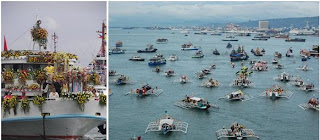Why they called it " SINULOG? "
The word Sinulog comes from the Cebuano adverb sulog which roughly means "like water current movement;" it describes the forward-backward movement of the Sinulog dance. The dance consists of two steps forward and one step backward, done to the sound of drums. The dance is categorized into Sinulog-base, Free-Interpretation. Candle vendors at the Basilica continue to perform the traditional version of the dance when lighting a candle for the customer, usually accompanied by songs in the native language.
The Sinulog is an annual festival held on the third Sunday of January in Cebu City, Philippines. The festival commemorates the Cebuano people’s pagan origin, and their acceptance of Roman Catholicism.
The festival features a street parade with participants in bright coloured costumes dancing to the rhythm of drums, trumpets and native gongs. Smaller versions of the festival are held in various parts of the province, also to celebrate and honor the Santo Niño. There is also a "Sinulog sa Kabataan" performed by the youths of Cebu a week before the parade. Recently, the festival has been promoted as a tourist attraction, with a contest featuring contingents from various parts of the country. The Sinulog Contest is usually held in the Cebu City Sports Complex.
The Sinulog celebration lasts for nine days, culminating on the final day with the Sinulog Grand Parade. The day before the parade, the Fluvial Procession is held at dawn with a statue of the Santo Niño carried on a pump boat from Mandaue City to Cebu City, decked with hundreds of flowers and candles. The procession ends at the Basilica where a re-enactment of the Christianizing (that is, the acceptance of Roman Catholicism) of Cebu is performed. In the afternoon, a more solemn procession takes place along the major streets
of the city, which last for hours due to large crowd participating in the event.
VIVA PIT SENIOR!!!











bongga!
ReplyDelete